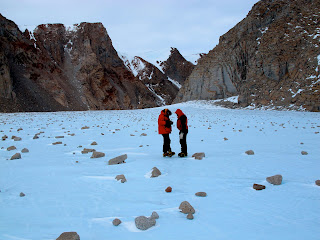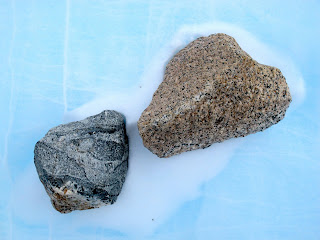Our first full day in camp was a grey, overcast day with no planned flights. As a result we spent the day looking at the basement rocks of Milan Ridge, just to the west of camp. So, we fired up the snowmobiles, hooked up the sleds, and rattled our way across the hard wind-packed snow and blue ice to the outcrops. The poor surface definition made for identifying crevasses more difficult a few of which were on the flanks of the Ascent Glacier.
A grey day. We snowmobiled to the edge of the blue ice west of camp. Visible in the background is the large “wind scoop” in the blue ice near the head of the glacier. The wind scoop is evidence of persistent winds down the Ascent glacier.
Tanya and John examining talus blocks beneath the outcrops on the Milan Ridge.
Garnet bearing granite gneiss.
Amphibolite clast in the wind sculptured blue ice.
Dylan Taylor surveying the scenery on Milan Ridge.
Amphibolite lens in a garnet bearing granitic gneiss
Lineated block of grey gneiss
Basement outcrop above the rolling blue ice. Note the line of snowmobiles on the blue ice to the left. Dylan Taylor at the bottom of the talus slope. The blue ice forms a steeply rolling surface here. Crampons required!
Dylan Taylor, John Goodge, and Mark Fanning examining the outcrop.
Later in the afternoon we went to look at the granites exposed on the other side of the Ascent Glacier. Here Dylan Taylor and John Goodge examine a sample in the rock strewn blue ice of Hockey Cirque.
Two contrasting clasts: A grey gneiss and a younger undeformed Ross granite.
Granite strewn blue ice in foreground. Steeply rolling sheets of blue ice in the background. This is near the wind scoop at the head of the Ascent Glacier east of camp.
A large granite block with smaller granite boulders in a depression in the blue ice.













No comments:
Post a Comment